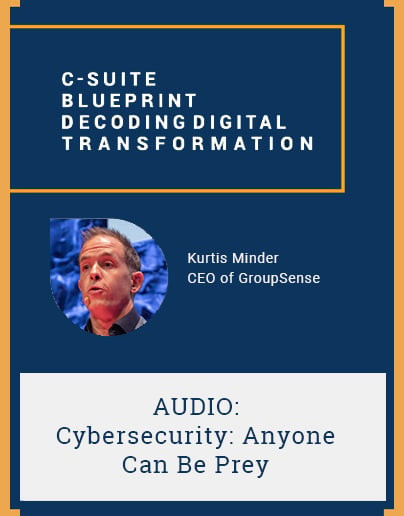C-Suite BluePrint: Decoding Digital Transformation
Cybersecurity should concern every American business, from Fortune 500 companies to mom-and-pop shops.
Corporations invest billions of dollars in cybersecurity annually, but thousands of small businesses are also affected by cyber-attacks and ransomware.
Kurtis Minder, CEO of GroupSense, has seen first-hand the devastating fallout from these vicious assaults. So, he and his team have made it their mission to shine a light on the digital cockroaches in cyber espionage.
Kurtis talked to us about:
- Security experts meeting cyber terrorists where they are
- Confronting the human connection in cybersecurity incidents
- How to react appropriately in case of a ransomware attack
Cyber Criminals are Adapting
“Bad guys use your data against you. Almost every single cyber breach is fed by corporate data in the wild that companies aren’t aware of.”— Kurtis Minder
The term “dark web” has become a sinister buzzword in the new millennium, but its origins date back to the 1960s with the forerunner of the modern internet, ARPANET.
Created initially as a research tool, the U.S. Defense Department inevitably absorbed ARPANET.
Despite being under government jurisdiction, several academic institutions had access to ARPANET’s network, including some students with ulterior motives.
In the early 1970s, students at Stanford and MIT participated in the world’s first known commercial transaction on the internet: an illegal marijuana purchase.
Of course, the internet has seen incredible transformation since then, and the dark web has evolved with it.
But while problematic, the dark web isn’t a grand mystery. Technically, any webpage that doesn’t appear in a general search index is part of the dark web.
So, naturally, these shadowy corners of the internet have become havens for ill-intentioned actors. However, as Kurtis pointed out, these cyber terrorists are getting smarter.
“It certainly is useful to monitor the dark web,” he said. “But the threat actors are not stupid. They know that’s being monitored, and they’re increasingly finding other channels in which they can transact their illicit activities.”
And those channels include legitimate digital communities and hosting services.
“Those places could be chat rooms. It could be WhatsApp groups,” Kurtis said. “It’s not just the dark web.”
As these digital cockroaches expand their reach, businesses and employees must stay vigilant in following cybersecurity protocols.
Ransomware: An Equal Opportunity Destroyer
“I think it’s unreasonable to expect the average small business owner to understand and mitigate the risks associated with technology adoption. It’s changing so fast.”— Kurtis Minder
Despite a global uptick in cybersecurity efforts, ransomware attacks have become progressively prevalent.
Not only have average ransomware payments skyrocketed over the last two years, but the blast radius of these incidents has also grown.
The average operational downtime from these attacks was 19 days in 2020. In 2021, that number rose to 22 days.
“This is a complete business interruption,” Kurtis said. “And in a lot of cases, the companies are in a position where, if they don’t solve it quickly, they go out of business.”
And the brutal reality behind this grim scenario is that every business with a direct line to the internet is at risk.
While most corporations invest in some level of cybersecurity, no defense is invincible. Yet, as Kurtis explained, the aftershock from these attacks for multi-billion dollar companies as opposed to small businesses is a stark contrast.
As financially impactful as ransomware attacks are, corporations have the resources to recover. But that’s often not the case with small businesses.
“In the large cases… yes, it is very emotional. Yes, those people are upset,” Kurtis said. “But it is a night and day difference when you’re talking to ‘Mary,’ who’s going to lose the business she’s been building for 25 years.”
Unfortunately, several of those scenarios that Kurtis has been a part of didn’t have a happy ending.
“They’ll pay a financial consequence or go out of business,” he said. “Some of them choose to take it on the chin. And I respect that.”
The Ransomware Victim Playbook
“We know the game plan for most of these guys at this point on what they expect.” — Kurtis Minder
A ransomware attack can happen to anyone, but Kurtis shared immediate steps you can take to mitigate the potential damage.
Ironically, the first thing you should do is ignore a classic IT cliche.
“[The ransom notes] tell you not to shut off your machines or reboot,” Kurtis said. “If you reboot, you’re never getting that machine back, so just let it go.”
The perpetrators will also include written instructions for navigating their dark web portal to submit a ransom payment. But Kurtis stated that you need a plan before visiting the indicated site.
“When you go there, a lot of the sites will have this clock, and it usually has a threat attached to it.”
Before that clock starts ticking, you need an action plan, whether meeting the criminal’s demands or seeking an alternative.
Regardless, anyone under the immediate threat of ransomware should seek out cybersecurity professionals who have trained to handle these cases.
“It’s important to understand the psychology of the bad guys,” Kurtis said. “But you also need an objective party.”
By removing emotions from the equation, experts like Kurtis can save your business from a doomsday scenario.
Bigger Than Data
To the bad guys, these cyber attacks are just another data heist.
But the lives of those affected by these crimes can be turned upside down instantly.
Small to mid-size business owners and executives must be vigilant in cybersecurity. And with proper training, employees can become your most significant wards against data breaches instead of liabilities.
By spreading cybersecurity awareness, you can protect your company - and its people - from ransomware.
Craving more? You can find this interview and many more by subscribing to C-Suite Blueprint on Apple Podcasts, on Spotify, or here.
